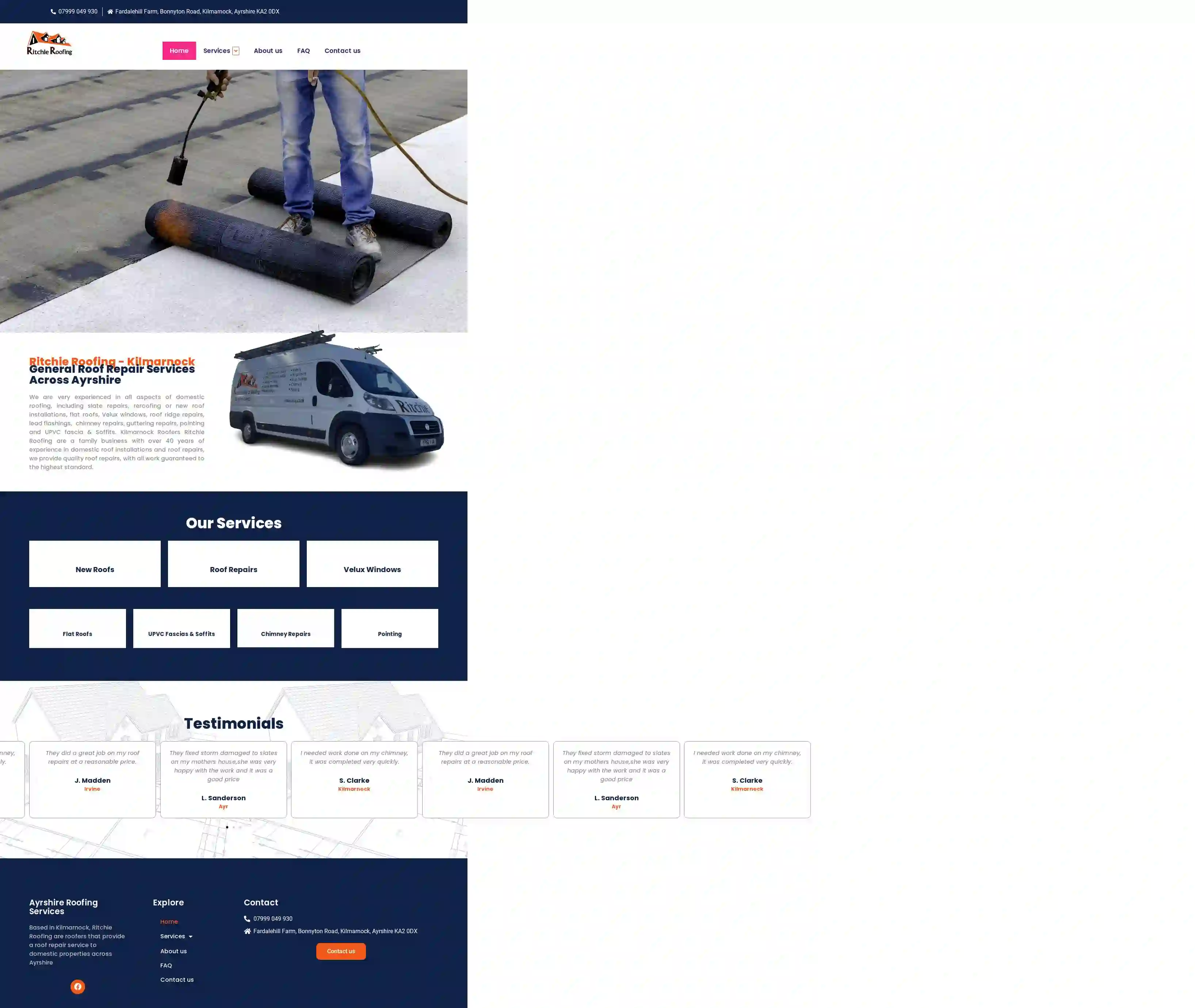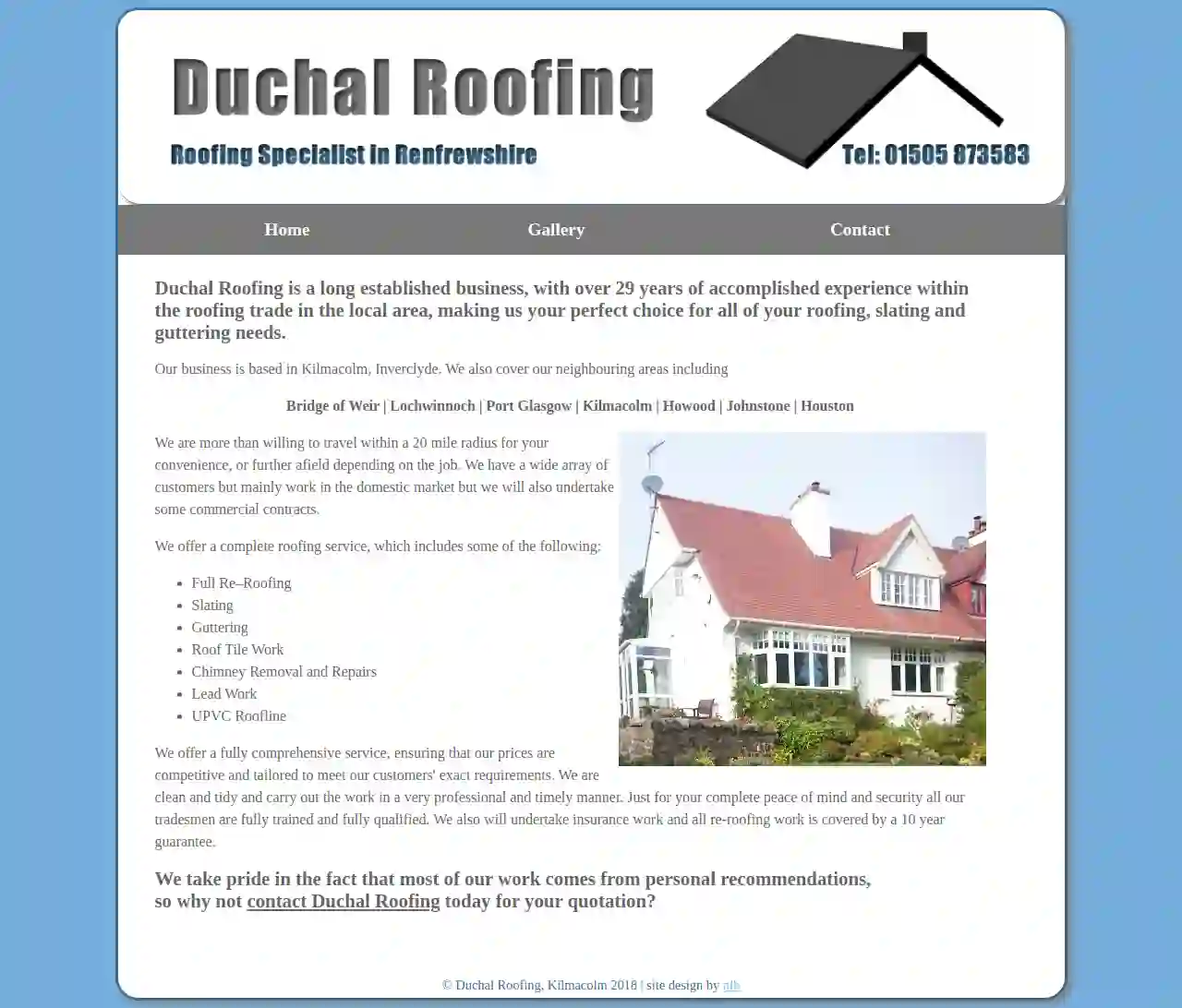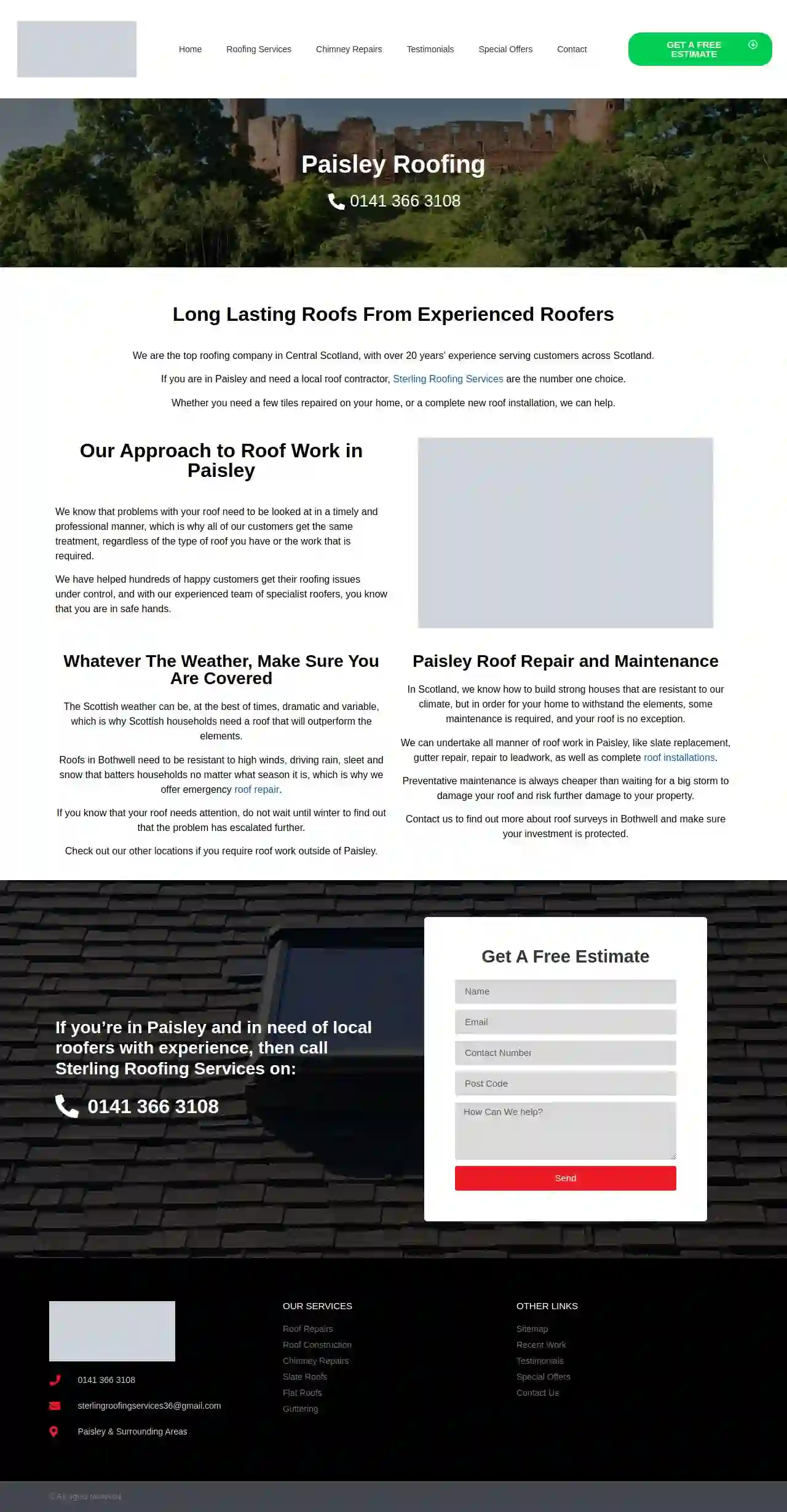Roofing Companies Hurlford
Find top Roofing Contractor in Hurlford
Receive up to 3 Roofing Companies quotes for your project today! Compare profiles, reviews, accreditations, portfolio, etc... and choose the best service.

B Varey and son ltd
4.944 reviews83 Cadzow Street, Hamilton, ML3 6DS, GBWelcome to B Varey & Son, Scotland's Wall & Roof Coating Experts. We offer a range of roofing and exterior maintenance services, completed by approachable and experienced tradesmen. We specialise in providing weatherproof coatings for surfaces such as roofing, walls and driveways. Our specialised applications will protect those areas for many years and reduce your maintenance costs too! For any home or commercial roof, wall or driveway restoration contact the experts today. Call Us Today On 01698 446758 For a Free Quote.
- Services
- Why Us?
- Testimonials
- Gallery
Get Quote
Garage Roof Replacement Glasgow (Asbestos Cladding & Repair)
3 Heath Avenue, Bishopbriggs, G64 1NA, GBGarage Roofs Glasgow Ltd. is a company with a strong reputation, working in partnership with Collins Roofing & Solar Solutions with over 50 years combined experience working in the roofing industry in Glasgow and Central Scotland. Our teams have installed thousands of flat roofs and garage roofs across Scotland, providing the best value in the country echoed by our perfect track record of strong customer reviews. We have a strong background in all aspects of roofing, however, we are specialists in garage roofing and flat roofing installing literally thousands of these types of roofs across Scotland over the years. As stated above our areas of expertise includes garage roof replacement and repair, asbestos garage roof overcladding & replacement and all aspects of flat roofing including EPDM Firestone rubber roof application.
- Services
- Why Us?
- Accreditations
- Our Team
- Testimonials
- Gallery
Get Quote
Ritchie Roofing Services
59 reviewsFardalehill Farm, Bonnyton Road, Kilmarnock, KA2 0DX, GBRitchie Roofing - Kilmarnock General Roof Repair Services Across Ayrshire We are very experienced in all aspects of domestic roofing, including slate repairs, reroofing or new roof installations, flat roofs, Velux windows, roof ridge repairs, lead flashings, chimney repairs, guttering repairs, pointing and UPVC fascia & Soffits. Kilmarnock Roofers Ritchie Roofing are a family business with over 40 years of experience in domestic roof installations and roof repairs, we provide quality roof repairs, with all work guaranteed to the highest standard. Our Services New Roofs Roof Repairs Flat Roofs Velux Windows UPVC Fascias & Soffits Chimney Repairs Pointing
- Services
- Why Us?
- Testimonials
- Gallery
Get Quote
I D Property Services
4.65 reviewsGBPeace of Mind We are an Ayrshire based local business, serving the central belt and beyond. Services Roughcasting Rendering UPVC cladding External Renovation No Sales team, Just Trades specialist We have NO sales team so you can ensure you will be liaising directly with an experienced tradesman who will offer you their extensive advice and expertise on every product which we offer. Full Customer Experience Service WE ensure that we commit to the time frames agreed and most of all deliver a service which exceeds our customers’ expectations. Ayrshire Roughcasting carry full employers and liability insurance. Our team are polite, respectful, and always courteous. Our team are QUICK, EASY and TIDY, ensuring maximum satisfaction for our customers with NO STRESS! At Ayrshire Roughcasting, we understand that a home is more than bricks and mortar, it is your family’s nucleus, where you eat sleep and make memories. We therefore make it our priority to ensure that your home is safe, secure and aesthetically pleasing too! We offer a wide variety of services in the home improvement sector, we are always happy to guide and advise our customers with any questions or enquiries that they may have. Our full range of services will provide not only protection and heat to your home, yet also gives a new lease of life to tired and outdated décor. We have a huge range of colours, textures and finishes to choose from which will compliment the style of your home. Our roofing services cover everything from UPVC fascia, soffits, guttering and led work. We also install full roofs and all roofing repairs. An added bonus to our services is our roof maintenance where one of our team will regularly inspect your roof and advise of any required repairs. We can do it all! Contact Us Ready to take the first step? Ayrshire Roughcasting are always looking for experienced tradesmen with extensive knowledge in the roughcast and rendering sector. If this sounds like you and you are looking for a new challenge in a fast paced environment then we would love to hear from you. Mobile: 07951 098051 Telephone: 01290 426451 Follow Us On:
- Services
- Why Us?
- Gallery
Get Quote- Pr
Prestige contractors
Ayr, GBPrestige Contractors is a family owned and operated business serving the greater New York City area. We specialize in all aspects of construction, from small renovations to large commercial projects. Our team of experienced professionals is dedicated to providing our clients with the highest quality workmanship and customer service.
- Services
- Why Us?
- Gallery
Get Quote 
C3 Scotland Limited
51 reviews12 Southview Road, Strathblane, G63 9JQ, GBWe are a roofing and cladding company, based in Glasgow and serving central Scotland.C3 Scotland Limited is a forward thinking and dynamic company that will cover all aspects of roofing and cladding works across Scotland. Employing only experienced roofers and cladders, we undertake a wide range of roofing projects from small roof repairs to large warehouses. At C3 Scotland Ltd in Glasgow, we pride ourselves on our precision and attention to detail with customer satisfaction on every project guaranteed. We encourage early client and contractor engagement to further maximise your journey, ensuring we provide the best value for your needs.Our extensive knowledge and experience in this sector helps us to understand and meet the requirements of our clients, providing a quality, hassle free service. Contact C3 Scotland Ltd in Glasgow for more details.
- Services
- Why Us?
- Our Team
- Testimonials
- Gallery
Get Quote
The Skyline Group
4.130 reviewsGlasgow, GBAt The Skyline Group, we offer a full range of home renovations. Whether you want to update the aesthetic of your property, create more space or improve energy efficiency, we can help. Our fully qualified in-house tradesmen only use quality products to ensure the best finish for you. If you’re looking to make changes to your home, no matter how large or small, contact The Skyline Group today. Our team of experienced in-house professionals improve the homes of Glasgow and the Central Belt. Whether you want stylish new windows to welcome you home, or a garage conversion to maximise space, trust The Skyline Group to provide a comprehensive, quality service – whatever the job! In recent years, the company has grown from strength to strength, establishing ourselves as a leading contractor and providing our specialist products and services to both residential and commercial clients.
- Services
- Why Us?
- Gallery
Get Quote
Duchal Roofing
3.73 reviewsKilmacolm, PA13 4AE, GBDuchal Roofing is a long established business, with over 29 years of accomplished experience within the roofing trade in the local area, making us your perfect choice for all of your roofing, slating and guttering needs. Our business is based in Kilmacolm, Inverclyde. We also cover our neighbouring areas including Bridge of Weir, Lochwinnoch, Port Glasgow, Kilmacolm, Howood, Johnstone, and Houston. We are more than willing to travel within a 20 mile radius for your convenience, or further afield depending on the job. We have a wide array of customers but mainly work in the domestic market but we will also undertake some commercial contracts. We offer a complete roofing service, which includes some of the following: Full Re–Roofing, Slating, Guttering, Roof Tile Work, Chimney Removal and Repairs, Lead Work, UPVC Roofline. We offer a fully comprehensive service, ensuring that our prices are competitive and tailored to meet our customers' exact requirements. We are clean and tidy and carry out the work in a very professional and timely manner. Just for your complete peace of mind and security all our tradesmen are fully trained and fully qualified. We also will undertake insurance work and all re-roofing work is covered by a 10 year guarantee. We take pride in the fact that most of our work comes from personal recommendations, so why not contact Duchal Roofing today for your quotation?
- Services
- Why Us?
- Gallery
Get Quote
Sterling Roofing Services Paisley - Roofer Paisley
59 reviewsPaisley, PA3 1, GBSterling Roofing Services is a top-rated roofing company serving Central Scotland for over 20 years. We specialize in all aspects of roofing, from repairs and maintenance to new installations. Our experienced team of roofers provides high-quality workmanship and a 100% satisfaction guarantee. We understand the importance of a reliable roof, especially in Scotland's unpredictable weather. That's why we offer emergency roof repair services to ensure your home is protected. Whether you need a few tiles repaired or a complete roof replacement, Sterling Roofing Services is here to help. We serve Paisley and surrounding areas, including Bothwell, Glasgow, and Stirling.
- Services
- Why Us?
- Testimonials
- Gallery
Get Quote
Bell roofing and property contractor Ltd
Glasgow, GBCOMING SOON “Sorry for the dust! We know it’s taking a while but sit tight and we’ll be with you soon. We are working hard to bring you our brand new, shiny website. In the meantime, we still want to hear from you so please leave us your email below and we will be happy to contact you. Alternatively, send your query to [email protected] or call us on 01355 200573”
- Services
- Why Us?
- Gallery
Get Quote
Over 12,314+ Roofers on our directory
Our roofing pros operate in Hurlford & beyond!
Roofyng.co.uk has curated and vetted the Best Roofing Businesses in and around Hurlford. Find a top & reliable pro today.
Frequently Asked Questions About Roofing Companies
- Leaks or Water Stains: Water stains on ceilings or walls, dripping water, or dampness in the attic.
- Missing, Cracked, or Curled Shingles: Inspect for damaged or missing shingles, especially after a storm.
- Damaged Flashing: Look for rust, corrosion, or gaps in flashing around chimneys, vents, or skylights.
- Sagging or Uneven Rooflines: A sagging roof could indicate structural problems.
- Granule Loss: Excessive granules in gutters suggest aging asphalt shingles.
- Moss or Algae Growth: Can trap moisture and damage roofing materials.
- Ventilation: Soffit vents provide intake ventilation, allowing fresh air to enter the attic and regulate temperature and moisture.
- Aesthetics: It creates a finished look to the roof's underside.
- Pest Control: A properly sealed soffit prevents pests like birds and squirrels from nesting in the attic.
- Safety First: Avoid going onto the roof during a storm, as it's dangerous.
- Document the Damage: Take photos and videos of the damage for insurance purposes.
- Contact Your Insurance Company: Report the damage to your insurance company as soon as possible to initiate a claim.
- Temporary Repairs: If safe, address any immediate leaks using buckets or tarps to minimize further damage.
- Contact a Roofing Contractor: After the storm, have a qualified roofing contractor inspect the roof and provide a repair estimate.
What are some common signs of roof damage?
What is a soffit, and why is it important for my roof?
What should I do if my roof is damaged in a storm?
How often should I clean my gutters?
What are some common signs of roof damage?
- Leaks or Water Stains: Water stains on ceilings or walls, dripping water, or dampness in the attic.
- Missing, Cracked, or Curled Shingles: Inspect for damaged or missing shingles, especially after a storm.
- Damaged Flashing: Look for rust, corrosion, or gaps in flashing around chimneys, vents, or skylights.
- Sagging or Uneven Rooflines: A sagging roof could indicate structural problems.
- Granule Loss: Excessive granules in gutters suggest aging asphalt shingles.
- Moss or Algae Growth: Can trap moisture and damage roofing materials.
What is a soffit, and why is it important for my roof?
- Ventilation: Soffit vents provide intake ventilation, allowing fresh air to enter the attic and regulate temperature and moisture.
- Aesthetics: It creates a finished look to the roof's underside.
- Pest Control: A properly sealed soffit prevents pests like birds and squirrels from nesting in the attic.
What should I do if my roof is damaged in a storm?
- Safety First: Avoid going onto the roof during a storm, as it's dangerous.
- Document the Damage: Take photos and videos of the damage for insurance purposes.
- Contact Your Insurance Company: Report the damage to your insurance company as soon as possible to initiate a claim.
- Temporary Repairs: If safe, address any immediate leaks using buckets or tarps to minimize further damage.
- Contact a Roofing Contractor: After the storm, have a qualified roofing contractor inspect the roof and provide a repair estimate.